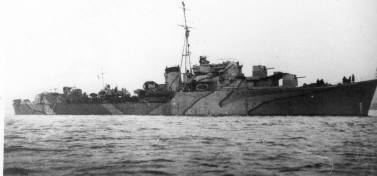Name HMS Pakenham Laid down 6 February 1940 Construction started 6 February 1940 Length 105 m | Ordered 20 October 1939 Completed 4 February 1942 Launched 28 January 1941 Draft 2.7 m | |
 | ||
Namesake Admiral Sir Thomas Pakenham Honours andawards Battle honoursDiego Suarez 1942Mediterranean 1942–43 Builders Hawthorn Leslie and Company, Hebburn | ||
HMS Pakenham (G06) was a P-class destroyer of the British Royal Navy built and operated during World War II. Commissioned in early 1942, she took part in the invasion of Madagascar, and several Malta Convoys, before being disabled in a battle with Italian torpedo boats in April 1943, and scuttled.
Contents
Service history
Pakenham was ordered from Hawthorn Leslie and Company at Hebburn on 2 October 1939, as part of the War Emergency Programme, and laid down as Onslow on 6 February 1940. She was launched on 28 January 1941. In August 1941, during construction, her name was changed to Pakenham. She was fitted with additional facilities to act as flotilla leader, and was finally completed on 4 February 1942.
Under the command of Captain Eric Barry Kenyon Stevens, Pakenham sailed to the Indian Ocean in April 1942 to take part in Operation Ironclad, the amphibious landing to capture of the port of Diego Suarez, at the start of the British campaign to capture the Vichy French-controlled island of Madagascar.
Pakenham was then transferred to the Mediterranean Fleet based at Alexandria, and took part in Operation Vigorous, a failed attempt to escort a convoy taking supplies to the besieged island of Malta. In August she took part in a diversionary operation during Operation Pedestal, which succeeded in getting several supply ships to Malta despite heavy losses.
In October Pakenham was one the ships that attacked and forced to the surface the German submarine U-559. Abandoned by her crew, the submarine was boarded by men from Petard and vital codebooks were recovered before she sank.
In November and December she took part in two successful convoys to Malta (Operation Stone Age and Operation Portcullis).
Pakenham had a series of successes in January 1943. In company with Hursley she sank the Italian Squalo-class submarine Narvalo on the 14th; sank the Italian naval auxiliary Tanaro on the 16th; and along with Nubian and the Greek Vasilissa Olga, Pakenham sank the Italian transport ship Stromboli on the 18th.
Sinking
Now under the command of Commander Basil Jones, early on 16 April Pakenham and Paladin engaged the Italian Spica-class torpedo boat Cigno and Cassiopea, which were the forward escort of the transport ship Belluno. While Belluno slipped away, the warships fought a short action, in which Cigno was disabled by gunfire, then torpedoed and sunk. Cassiopea limped away badly damaged. However, Pakenham was hit by shell fire six times, disabling her engines and a boiler. Ten members of her crew were killed in action. Paladin attempted to tow her to Malta, but by morning the threat of enemy air attacks forced her to embark Pakenham's crew, and then sank her by torpedo southwest of Sicily at position 37°26′N 12°30′E.
